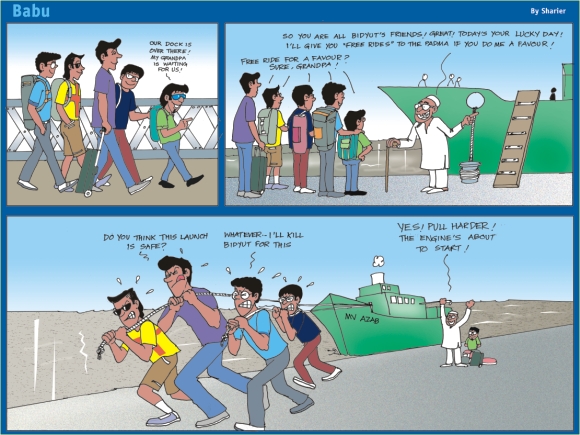
Sci News
By, Adnan M.S. Fakir
I am dolphin Fakir, he is dolphin Bottlenose, and you are dolphin Bangla Bhai…
With a brain larger than the brain size of humans, Bottlenose Dolphins, as well as other dolphins, have stunned many scientists over the past years and are the closest competitors to the ape kind in terms of intelligence; and more recently, the dolphins just grabbed another point for themselves. They are now probably the next species to humans who can “name” themselves!
Unlike in our case, however, papa dolphins and mama dolphins do not name their baby dolphins, but instead as infants they select their own names. Of course, their names are not in words like us, but instead in their own mean of communicating… endless hours of high pitched whistling! It was first discovered in bottlenose dolphins (dolphins with actual bottle-like noses three inches long) as “conversations” between several of them were recorded over time in which the scientists noticed that a few notes were being produced by the dolphins a lot more times than others. The scientists computerized those specific notes (the signature whistles), keeping their basic pitch contour same, and played it to the dolphins using an underwater speaker.
The scientists finally concluded that this “signature whistle” development in dolphins gives them a giant evolutionary advantage by helping individuals recognize each other and to maintain cohesion in groups. However, it is with great dismay I must conclude that due to lack of hands, no dolphin hieroglyphics, have yet been discovered. Who knows, next scientists may even discover rats also having signature 'qweeeks' and communicating with each other, hatching up a master plan to get rid of the cat kind. With no cats to chase around, it is going to be good news for Boo though.
Of Moons and Spiky Dusts
If the Bush administration's plan to set up a base on the moon is to become a reality, scientists will first have to devise a way to deal with a tiny but ubiquitous enemy: lunar dust. Whoever thought that dust would be such a menacing threat? But in fact moon dust is not like normal dust like in Earth - made while meteoroids hit the moon, reducing rocks to jagged dust; it's a process of hammering and smashing making the dust like powdered glass, extremely abrasive and hence clinging that is hard to get rid off.
After every moonwalk (called an EVA) moon-dust used to cling to the astronauts spacesuit, being almost impossible to wipe, and airborne moon-dust would get inside the Lander. From there the astronauts first experienced their direct encounter with it.
They found the moon dust to be soft like snow flakes, yet abrasive, taste 'not bad' and smell like burnt gunpowder, although its chemical constituents are nothing at all like that of burnt gunpowder. Want to smell the moon-dust?
Then be sure to take the space flight that the JTB Corp. is planning to offer from 2008 for a cost of $100 million; you just might get a sniff at the moon-dust's original smell, because, moon-dust brought back to Earth seems to have lost its smell, and smells nothing at all like burnt gun powder. Weird huh?
So how is the dust a problem? Well, the lunar dust has a structure similar to silica dust on Earth that causes a deadly disease called, silicosis, which has caused death of hundreds of miners. The dust particles have sharp angles, with arms that stick out like little hooks and are less than 10 microns (for comparism, human hair is a bit more than 50 microns wide). When breathed into the lungs, the dust can embed themselves deeply into the tiny alveolar sacs and ducts where oxygen and carbon dioxide gases are exchanged. There, the lungs cannot clear out the dust by mucus or coughing. Moreover, the immune system's white blood cells commit suicide when they try to engulf the sharp-edged particles to carry them away in the bloodstream. Eventually the lungs can be filled with proteins from the blood, and it's as if the victim slowly suffocates to death.
NASA plans to send people back to moon in 2018 to study this, although we certainly do not know how by many years it's going to be delayed. Nonetheless, we can be sure of one thing though, hopefully our 20th generation's grandchildren's grandchildren will be able to visit the base on the moon, hopefully…
